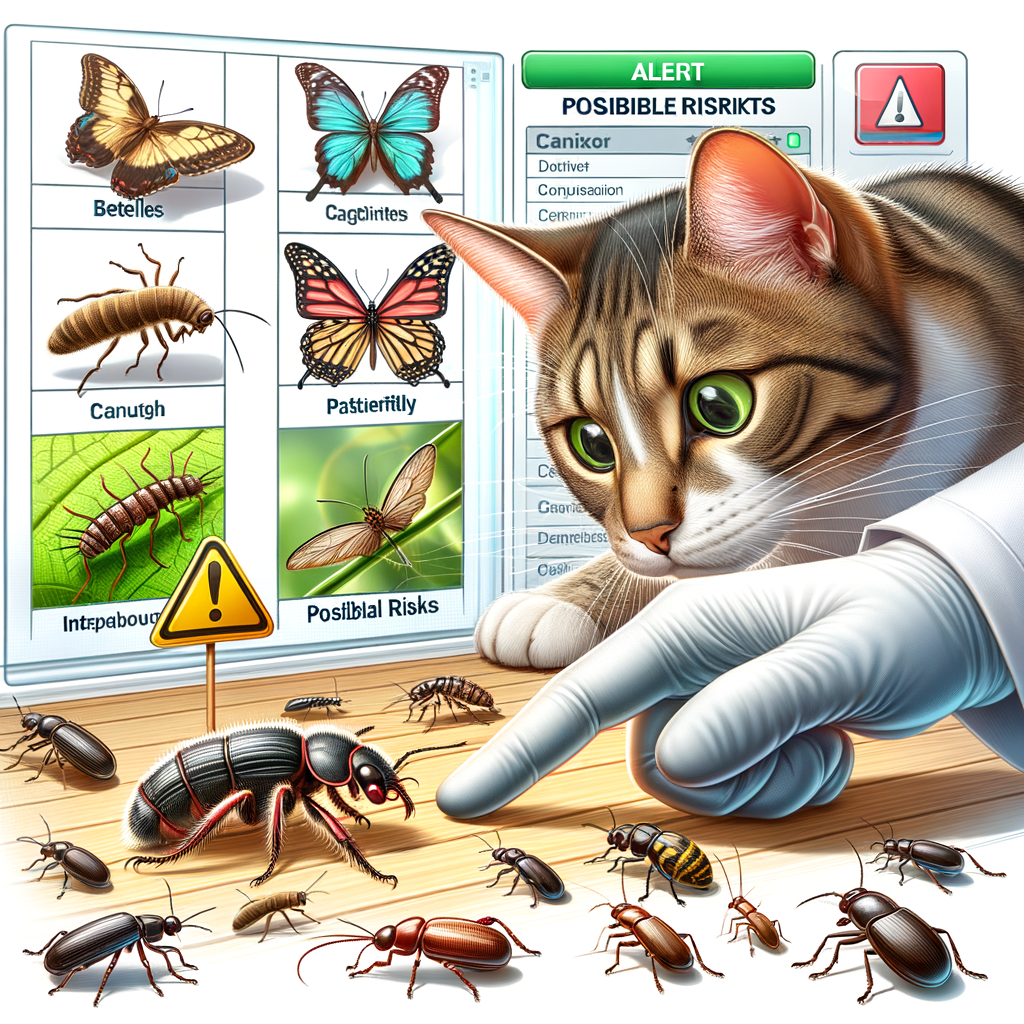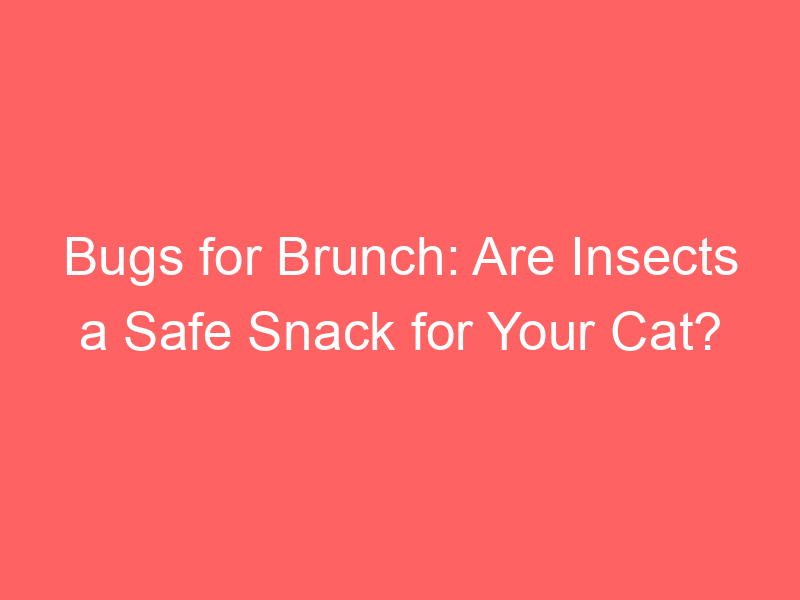
Introduction to Cats Eating Insects
Have you ever wondered why your furry friend is so fascinated by those tiny creatures buzzing around? Cats and insects have a unique interaction that many of us may not fully understand. This article will delve into the world of cats and their insect-eating habits, providing you with insights and interesting facts.
- Overview of Cats and Insects Interaction
- Common Insects Cats Encounter
Cats are natural hunters. Their sharp claws, keen eyesight, and quick reflexes make them excellent predators. Insects, with their erratic movements and buzzing sounds, often catch a cat’s attention and trigger their hunting instincts. Cats often chase, play with, and sometimes eat these insects. This behavior is not just about hunting for food, but also about mental stimulation and exercise.
Cats come across a variety of insects in their daily life. Some of the most common ones include flies, spiders, moths, and beetles. Each of these insects can provide a different kind of ‘play’ experience for cats. Flies and moths, for example, are fast and can fly, making them challenging and exciting targets. Spiders and beetles, on the other hand, move slower but can be intriguing due to their unique movements and textures.
While it’s normal for cats to be interested in insects, it’s important to ensure their safety. Not all insects are safe for cats to eat. In the following sections, we’ll discuss the safety of cats eating bugs and the pros and cons of insects in a cat’s diet.
The Safety of Cats Eating Bugs
When it comes to our feline friends, it’s important to understand their natural behaviors and instincts. One such instinct is their tendency to hunt and eat bugs. But is it safe for them? Let’s delve into this topic.
Understanding the Cat’s Natural Hunting Instinct
Cats are natural-born hunters. This instinct is ingrained in their behavior from their wild ancestors. Hunting not only provides them with food but also serves as a form of exercise and mental stimulation. However, it’s important to note that not all prey is safe for consumption, especially when it comes to insects.
- Role of hunting in a cat’s behavior
- Why cats are attracted to insects
Hunting is a natural part of a cat’s behavior. It’s an instinct that has been passed down from their wild ancestors. Even domesticated cats who are well-fed will often engage in hunting-like behaviors. This is because hunting provides them with mental stimulation and exercise. It’s a way for them to express their natural instincts and keep their skills sharp.
Cats are attracted to insects for a variety of reasons. Insects are small, fast, and unpredictable, which makes them an exciting target for cats. The movement of insects stimulates a cat’s predatory instincts, causing them to chase and capture the bug. Additionally, some cats may eat insects as a form of supplemental nutrition, especially if they are lacking certain nutrients in their diet.
In conclusion, while hunting and eating bugs is a natural behavior for cats, it’s important for cat owners to ensure that their pets are not consuming harmful insects. Always monitor your cat’s behavior and consult with a vet if you notice any changes in their health or behavior.
Potential Dangers of Cats Eating Insects
While cats are natural hunters and often enjoy chasing and eating insects, there are some potential dangers associated with this behavior. Let’s explore some of these risks.
- Insects harmful to cats
- Health risks associated with certain bugs
Not all insects are safe for cats to eat. Some bugs, like spiders and bees, can be harmful or even deadly to cats. For example, black widow spiders and brown recluse spiders are highly venomous and can cause serious harm if a cat tries to eat them. Similarly, bees and wasps can sting a cat in the mouth or throat, which can lead to swelling and difficulty breathing.
Even if an insect isn’t inherently harmful, it can still pose health risks to cats. Some bugs carry diseases or parasites that can be transmitted to cats. For instance, cockroaches can carry a range of bacteria and parasites, including salmonella and tapeworms. Similarly, fleas can transmit a variety of diseases to cats, including cat scratch fever and plague.
In conclusion, while cats may enjoy hunting and eating bugs, it’s important for cat owners to be aware of the potential dangers and to take steps to protect their feline friends. This might include keeping cats indoors, using insect repellents, or providing safe toys for cats to chase and play with instead of bugs.
| Insect | Potential Harm to Cats |
|---|---|
| Black Widow Spider | Highly venomous, can cause serious harm |
| Bee/Wasp | Can sting, leading to swelling and difficulty breathing |
| Cockroach | Can carry bacteria and parasites, including salmonella and tapeworms |
| Flea | Can transmit diseases, including cat scratch fever and plague |
Insects in Cat Diet: Pros and Cons
When it comes to feeding our feline friends, we often wonder about the best diet for them. One question that frequently comes up is whether insects can be part of a cat’s diet. Let’s delve into the pros and cons of including insects in a cat’s diet.
Benefits of Insects in a Cat’s Diet
Despite the initial surprise, there are indeed several benefits of including insects in a cat’s diet. Let’s take a closer look at them.
- Nutritional value of certain bugs
- Bugs safe for cats to eat
Some insects are packed with nutrients that are beneficial for cats. For instance, crickets are rich in protein, fiber, and essential vitamins and minerals. They provide a balanced diet that can supplement a cat’s regular meals. Similarly, mealworms are a good source of protein and fat, making them a nutritious snack for cats.
While not all bugs are safe for cats to eat, several are harmless and can even be beneficial. Crickets, mealworms, and silkworms are a few examples of bugs that are safe for cats. They are non-toxic and do not carry diseases, making them a safe choice for your feline friend. However, it’s crucial to source these insects from reliable suppliers to ensure they are free from pesticides and other harmful substances.
In conclusion, while the idea of feeding insects to your cat might seem strange at first, it can have several benefits. However, it’s essential to do your research and consult with a vet before making any significant changes to your cat’s diet.
Drawbacks of Insects in a Cat’s Diet
- Potential Health Risks
While some insects can be a source of protein for cats, others may carry diseases or toxins that can harm your pet. For instance, some bugs may be hosts to parasites which can cause digestive issues in cats.
- Challenges in Controlling the Quality and Safety of Insects
Unlike commercial pet food, the quality and safety of insects cannot be easily controlled. Insects from the outdoors may have been exposed to pesticides or other harmful substances, posing a risk to your cat’s health.
- Examples of Cats Feasting on Insects
Many cat owners have stories of their pets chasing and eating bugs. While this may seem like harmless fun, it’s important to remember that not all insects are safe for cats to eat.
- Insights from Veterinarians and Cat Behaviorists
Veterinarians and cat behaviorists generally advise against allowing cats to eat insects. The potential health risks outweigh the small amount of protein that bugs provide.
- Understanding Your Cat’s Behavior Towards Insects
Cats are natural hunters, and their interest in bugs is often more about the chase than the meal. Understanding this can help you provide safer alternatives for your cat’s hunting instincts.
- Knowing Which Insects are Safe and Harmful
While some insects like certain types of moths or butterflies can be harmless, others like spiders or bees can be dangerous for cats. It’s important to know which bugs are safe and which ones to keep your cat away from.
- Importance of Monitoring Your Cat’s Interaction with Bugs
Keeping a close eye on your cat’s interaction with bugs can help prevent potential dangers. If you notice your cat playing with a bug, it’s best to remove the insect and distract your cat with a toy.
- How to Prevent Potential Dangers of Cats Eating Insects
Preventing your cat from eating insects can be as simple as keeping your home bug-free and providing plenty of safe toys for your cat to play with. Regular vet check-ups can also help catch any potential issues early.
- Final Thoughts on Cats and Insects Interaction
While cats may be naturally inclined to chase and eat bugs, it’s important for their health that we discourage this behavior. By understanding the potential risks and taking steps to prevent them, we can keep our feline friends safe and healthy.








